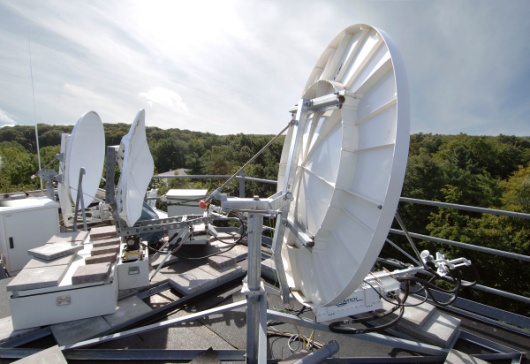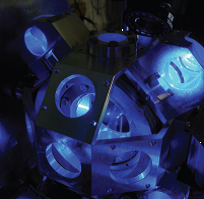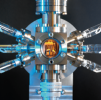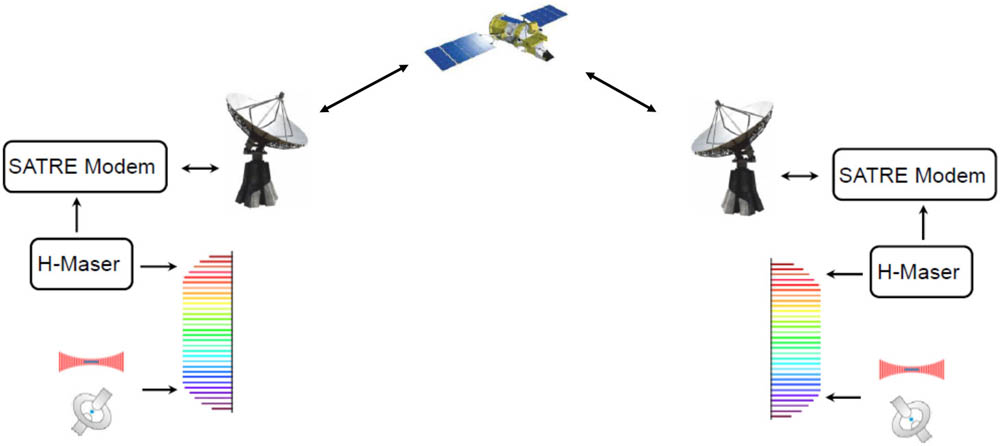WP5 Remote clock comparisons via satellite links and analysis for timescale steering

Workpackage leader: Dr Erik Benkler, PTB
Other participants: INRIM, LNE, NPL, OBSPARIS
The aim of this workpackage was to investigate necessary prerequisites for using optical clocks to provide steering contributions to International Atomic Time (TAI). This included the investigation of improved methods for frequency comparisons between remote clocks and the development of new methods for analysing sets of clock comparison data.
Remote clock comparisons via satellite links
Today, multiple time and frequency transfer techniques are being operated continuously and provide regular data for the computation of TAI. While these techniques are suitable for the current generation of clocks, a significantly better frequency transfer capability is required to exploit the full potential of optical clocks for TAI steering.
Within this project we investigated a broadband version of two-way satellite time and frequency transfer (TWSTFT). The TWSTFT links currently used in the computation of TAI are based on a bit rate of 1 MChip/s. In our experiments a chip rate of 20 MChip/s was used, with the goal being a reduction of instability by one order of magnitude.
The setup used for our experiments is shown above. The broadband TWSTFT measurements were used to compare the frequencies of reference active hydrogen masers in the laboratories at each end of a link. As an independent method, GPS frequency comparisons were also performed using the precise point positioning (PPP) concept. Optical clock comparisons were performed by measuring simultaneously the frequencies of the optical clocks at each of the participating laboratories (INRIM, NPL, LNE/OBSPARIS and PTB) directly against the local reference maser, using femtosecond optical frequency combs.
Our experiment is by far the most extensive remote optical clock comparison that has ever been performed, involving seven different optical clocks in four different laboratories over a 26-day period. 87Sr optical lattice clocks were operated at NPL, OBSPARIS and PTB, 171Yb+ trapped ion optical clocks were operated on the E3 transition at NPL and PTB, the 199Hg optical lattice clock was operated at OBSPARIS and INRIM contributed their newly operational 171Yb optical lattice clock. The desire to gather as much clock comparison data as possible in a limited period of time proved a powerful stimulus to improve the robustness of the optical clocks. During the campaign, several of the optical clocks were operational for up to almost 90% of the time, not all that far behind the regularly operated caesium primary standards. These high operational duty cycles are an important technical prerequisite for optical clocks to make useful contributions to international timescales.
Analysis of the data collected proved significantly more challenging than for clock comparisons via optical fibre links, mainly due to the fact that the white phase noise and technical disturbances on the link data limit the instability and uncertainty of the optical clock comparisons. An optimized data analysis strategy therefore had to be developed to take these peculiarities into account. In this way link uncertainties in the low parts in 1016 range were finally achieved, which to our knowledge is the best result ever achieved with a telecommunications satellite.
An unexpected, but significant, conclusion from our experiment is that the recently introduced GPS integer precise point positioning (IPPP) technique has a similar performance to broadband TWSTFT in terms of the uncertainty that can be achieved for a given averaging time, but at considerably reduced operational cost and with less effort. GPS-IPPP has a clear advantage compared to broadband TWSTFT in that it is a robust technique that can readily be put into regular operation.
Analysis of data from optical clock comparisons
The clock comparison programme carried out within our project has led to a set of frequency ratio measurements between the high accuracy optical atomic clocks being developed within European NMIs, as well as a comprehensive set of absolute frequency measurements with uncertainties at the limit set by caesium primary frequency standards. This frequency ratio measurement matrix is over-determined, in the sense that it is possible to deduce some frequency ratios from the results of several different experiments.
Within our project a method has been developed for handling over-determined sets of clock comparison data in order to derive optimised values for the frequency ratios between each contributing standard. This is a least-squares adjustment procedure, based on the approach used by the Committee on Data for Science and Technology (CODATA) to provide a self-consistent set of internationally recommended values of the fundamental physical constants. This method has been demonstrated to reproduce the frequency values recommended by the International Committee for Weights and Measures, when using the same input data used to derive these values, and has been used to explore the effects of including more recent data in the analysis. Our work has also shown the importance of accounting for correlations between the input data.
Our least-squares analysis methods and software were used by the CCL-CCTF Frequency Standards Working Group in September 2015 to update the CIPM list of recommended frequency values.
Factors influencing the use of optical clocks for steering of TAI
Timescales must be realised without interruption for them to provide a continuous coordinate system for measuring the position of events in time. Compared to caesium fountain primary frequency standards, which now routinely operate for many days with minimal user intervention, the increased technological challenges and complexity of optical clocks currently limit the periods for which continuous operation can be achieved. Although significant improvements in this respect have been achieved within our project, it is still necessary to bridge gaps with a local flywheel frequency reference in order to obtain data that can be used for steering corrections to TAI. This flywheel results in an additional source of uncertainty.
We have shown that sufficiently stable hydrogen masers or optical cavities can be used as flywheel oscillators to bridge surprisingly long gaps in optical clock data without significantly degrading clock comparison uncertainties. Simulations have shown that a local timescale based on an optical clock with limited availability (< 50%) can have long-term performance better than one using the best present-day caesium fountain standards, even if those standards are operated without any interruptions. Other important contributions of our work have been the development of novel or enhanced tools for data analysis and statistical description of the data, such as gap-tolerant algorithms for modified Allan deviation estimation and optimal noise-suppression weighted averaging.

The research within this EURAMET joint research project receives funding from the European Community's Seventh Framework Programme, ERA-NET Plus, under Grant Agreement No. 217257.


